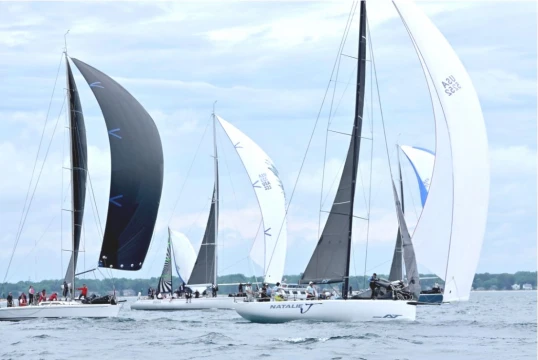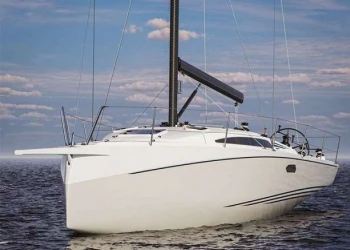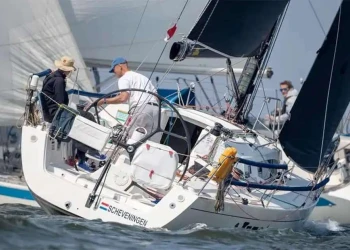
Photos by Martin Chumieki/Photo Element and Stephen Cloutier/Chicago YC
Record smashing number of entries for the 100th Bayview Mackinac Race
As of today there are 100 days left to Saturday July 20, 2024, the start date of the 100th Bayview Mackinac Race presented by National Fleet Services. This annual blue water classic held on Lake Huron and the Straits of Mackinac is the oldest continuously run freshwater race in the world. Already 313 monohull and 13 multihull boats ranging in length from 27 to 104 feet are entered, with teams hailing from 16 states throughout the US and 2 Canadian provinces.
Total number of entries before the registration deadline of June 1, 2024 are expected to top 350 - the previous record number of entries was 316 in 1985.
“This growth in participation speaks volumes about the enduring appeal and significance of the race within the sailing community,” says Michael Helm, 2024 Bayview Yacht Club Commodore. “While we anticipated an increase in the number of participants for our 100th, I attribute the immense response to a broader trend of people seeking outdoor activities and embracing the natural beauty that Michigan offers. Sailing, in particular, takes advantage of this and is an activity accessible for enthusiasts and newcomers alike.”
Unlike many editions of this race held in the past few decades, this year there is only one course that all entries in this massive fleet will sail: the 204-mile 1925 Original Course.
From its traditional start in southern Lake Huron, the entire fleet will head north along the Michigan shoreline before heading west, passing south of Bois Blanc Island, and finishing west to east at the finish line between Round Island and Mackinac Island, the site of the finish venue.
The original starting line in 1925 was three nautical miles south of the current one, located off Lake Side Park at Gratiot Beach. As the race grew in popularity, this starting line was eventually moved to its current location north of Port Huron so that there was sufficient length to the starting line and sufficient depth to accommodate large fleets of starters.
Winning the first edition of the race in 1925 was a 32-foot sloop skippered by Russ Pouliot named Bernida, who crossed the finish line at Mackinac Island in 48 hours, 49 minutes, and 49 seconds for an average speed of 4.2 knots. The 12 competitors in this race experienced blustery conditions that left all but four boats damaged and only six completing the course.
The current record for this course was set in 2021 by Oakcliff Sailing Center’s Reichel/Pugh MaxZ 86 OC 86 and was a little faster: 17 hours 11 minutes 19 seconds for an average speed of about 11.9 knots.
Will a new record be set on this year's race?
This is quite possible given the impressive array of amateur and professional talent among the fast boat entry crew lists. They just need steady wind conditions throughout the course...historically not always common in Bayview Mackinac races.
“This race is never the same, it’s always a challenge,” said last year’s overall winner Tim Prophit who raced his 1977 Dick Carter-designed North American 40 FAST TANGO to overall victory in a fleet of 75 entries on the longer 259-mile Cove Island Course. “The summer conditions on Lake Huron can vary widely from no wind to a pleasant breeze to wild and scary all within 24 hours.”
Prophit should know a thing or two about racing in the Lakes: not only did FAST TANGO win the Bayview Race but he and his team also won last year’s Chicago-Mackinac Race and the Trans Superior Race, a crowning achievement of offshore prowess for this “Double Goat” veteran of over 25 Chicago and 25 Bayview Mackinac races.
Prophit and 12 other entries are also signed up to compete in the 2024 edition of the SuperMac Race, a 495-mile race that starts on July 13 with the Chicago Mac Race fleet, passes by the finish line for that race at Mackinac Island, then finishes in Port Huron at the start line for the Bayview Mac Race that starts on July 20th. Those that do both races are intrepid indeed: this represents 700 miles of racing over two weeks on two Great Lakes.
It's also worth noting that on last year’s Shore Course, similar to the 1925 Original Course that will be used this year, it was another older design that prevailed as overall winner among 111 entries racing on that course: Jeremy Thompson’s 1969-designed Grampian 30 TRAV’LER.
Does this mean only older designs can win in this race?
“Absolutely not,” says Race Chairman Charlie Trost. “With the ORC rating system every boat has a handicap rating based on the boat’s measurements that are used to calculate its performance potential on our race course model of the wind speeds and angles of a typical race. Fast or slow, boats that do well are those that sail the fastest relative to their rating. Some years it is the fastest high-tech boats that win and in other years it is the slower traditional boats that prevail. Everyone has a chance so long as they sail well."
“We think this is why we get such a great turnout for this race, especially for this year’s milestone edition. Old and new, large and small, are all welcome.”
The largest boat entered thusfar in the fleet of 156 entries in Division I is Peter Thornton’s Bruce King-designed 104-foot ketch WHITEHAWK from Chicago, with the smallest being Kevin Brown’s Farr 30 NOTORIOUS from Toronto. In the 157-entry Division II the largest entry is Matt and Stephanie Nurre’s Farr Pilothouse 56 VANISHING POINT also from Chicago with the smallest being Pete Fitzpatrick’s Morgan 27 DEFIANT from St. Clair Shores, MI.
Among 13 entries in the Multihull division the largest is Todd & Ryan Howe’s Greene Formula 60 EARTH VOYAGER from Rochester, NY while the smallest is E. John VanSickle’s Corsair F-27 UNLEADED from Bay City, MI.
Another important feature of every Bayview Mackinac Race are the post-race celebrations held on beautiful Mackinac Island. From the finish of the first boat to the Island Awards Ceremony from 1200-1500 on Tuesday July 23, 2024 the island will be overrun by exuberant and festive sailors and their families and friends.





